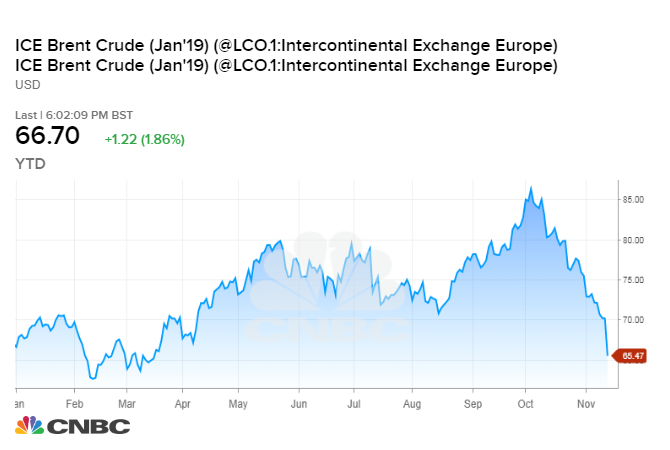The commodities chief at Goldman Sachs says the oil market sell-off is likely nearing its end and forecasts Brent crude will soon return to $75 a barrel.
Oil prices have lost about a quarter of their value in just six weeks, plunging the energy complex into a bear market. Brent crude, the international benchmark for oil prices, dipped below $65 a barrel this week, tumbling from a four-year high near $87 over the last six weeks.
The market has pinned the pullback on a broader stock market sell-off in October, forecasts that see oil demand growing less than originally anticipated, and rising oil supplies from major producers.
But Jeff Currie, head of commodity research at Goldman Sachs, believes supply and demand is only part of the story. He says investor positioning and one trading strategy in particular are largely responsible for deepening the oil market rout in recent days.

That suggests the worst losses for crude futures are likely in the rear view mirror.
"Our base case is we'll bounce around here," Currie told CNBC's "Squawk on the Street" on Wednesday. "I like to think about it like a pinball machine, but eventually the momentum is going to be to the upside."
Currie says concerns about deteriorating demand for oil are "overblown." More pressing, he says, is the surge in output from the United States and Libya, and the Trump administration's decision to allow eight countries to keep importing Iranian crude despite U.S. sanctions on the Islamic Republic.
Those factors added about 1 million barrels per day to the market, he said, but they still does not justify a more than 20 percent pullback in oil prices.
Currie believes the rapid decline over the last few days was driven by momentum trading, a strategy in which traders buy or sell assets as the price moves decisively higher or lower. That momentum selling largely accounts for U.S. crude prices falling below $60 a barrel and toward $55, according to Currie.
At that point, another quirk of the market kicked in. When oil fell to about $55, it triggered selling by swap dealers, who had sold options to oil producers giving them the right to sell the commodity at that price level.
Historically, this environment can last for three to four weeks, Currie says. However, rising volatility in oil markets will discourage momentum traders, who like low volatility markets that are either trending higher or lower.
"You take away the momentum players, then you need the physical catalyst," he said. "What's the physical catalyst? OPEC."
OPEC and its oil market allies are growing more vocal about the need for a fresh round of production cuts to prevent oversupply. The 15-nation cartel, along with Russia and other producers, has been limiting output since January 2017. However, they recently started hiking production to tame rising oil prices and compensate for the loss of Iranian exports.
Now, the group may need to remove nearly 1 million bpd from the market, Saudi Arabia's energy minister said on Monday. A committee representing the group reportedly discussed cutting output by as much as 1.4 million bpd at a meeting last weekend.
The producers will meet in Vienna in three weeks to discuss whether they will stay the course or throttle back output.
"I would put a production cut as being a high likelihood here, and that gets you out" of the current price environment, Currie said. "Historically you bounce right back to where you were before. Our target for first quarter this year is $75 a barrel on Brent."
Brent and U.S. crude rose nearly 2 percent on Wednesday above $66 and $56, respectively.
via IFTTT
No comments:
Post a Comment